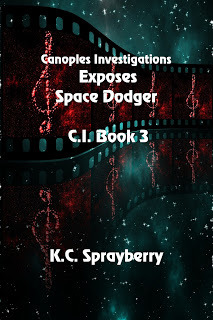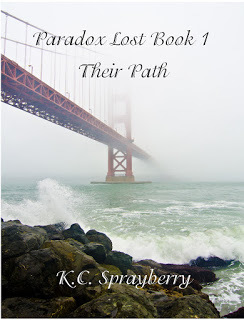K.C. Sprayberry's Blog, page 136
February 6, 2017
Mixed Up Plot Lines
Welcome to #2017MondayBlogs!
Have you ever read a book and wondered exactly what the plot was about. It seems from the first chapter that you’re confused as to what exactly is happening. You’re introduced to a plethora of characters and they all have different schemes on their minds. Nothing about this book makes any sense at all and the reader is often left angry.
Welcome to the world of a mixed up plot line. You, the author, have failed in your first task, to make clear what your book is about. You became involved with each character’s motivation without making clear the one thing that will bring all of them together. Now, you’re staring at reviews that are less than shining and can’t believe how that happened.
Your book’s plot needs to be clear and concise from the first page. This is the main feature of your novel. The worst thing you can about your plot is “It might be too complex for audiences to follow.”
The first thing you, the author, needs to remember is that there are seven basic plot lines. That’s right, just seven. Every book ever written falls into one of these categories:
Overcoming the Monster
The protagonist sets out to defeat an antagonistic force, which is threatening their world. Pretty simple to figure out this type of plot. The main character has an overwhelming force they must overcome in order to feel safe in their world.
Rags to Riches
Need we say more? A poor person becomes rich, with an interesting journey to their wealth. What counts as wealth isn’t just money, though. Perhaps their wealth is along the lines of happiness. Maybe they have to prove to others they can accomplish an impossible task.
The Quest
Most used in the fantasy genre, a quest can also be the determination of a teen to stand against the flow and be an individual. It can be a parent holding up their head when adversity destroys their dreams and they must start over. Any type of quest, no matter the genre, can be interesting and vital to the plot.
Voyage and Return
The main character travels to a strange land, has many adventures, and goes back to their home. Use your imagination to figure out if this strange land can be crossing the street or a continent. Maybe your character takes off for another galaxy to participate in a revolution. The possibilities are endless.
Comedy
Writing comedy has to be the hardest thing most authors will attempt. You’ll have to cater to your audience and ensure they understand your brand of funny, which might offend some of your readers. The book doesn’t have to remain lighthearted throughout, but that certainly is a major factor.
Tragedy
A major character flaw or great mistake is your protagonist’s undoing in this type of story. Making your main character sympathetic in this type of book is difficult. You need to avoid having their flaw/mistake so great that everyone will hate them. Another problem can be the resolution. It should be an understandable but not trite method of solving their problem.
Rebirth
A major event in your main character’s life forces them to change how they approach a problem, become better than they were in the past.
There is one other type of plot line, and this one is where the book can become confusing if done incorrectly. The Meta-Plot involves mixing of plot lines. It begins with an anticipation stage, where your main character is called into an adventure. This evolves into a dream stage, where the character’s success allows them to believe they are invincible and can’t fail. The character is then thrust into the frustration stage, where they face an antagonist and discover failure, or perhaps they defeat their enemy. The climax of this type of plot, the nightmare stage, leaves your main character lost, unable to figure out why they failed. In order to give your readers closure, you must segue into the resolution stage, giving your character the chance to redeem him/herself.
The Meta-Plot is where authors tend to make the mistake of confusing their readers. It’s too easy to attempt to put the full plot of the story into the first chapter. That leaves readers unsure what’s happening. When you design your plot, remember this…
Be clear about the intentions of your book. Don’t open your story in such a complex way that your readers are confused.
Published on February 06, 2017 00:00
February 5, 2017
Finding That Right Guy


The 2017 Everybody YA #SundayBookBlog continues with more fun, excitement, and tension!
Surviving a non-parental kidnapping and being hidden from your family leaves scars. These aren’t the type of scars that will eventually disappear. In fact, these scars aren’t really visible so that people can understand that you’ve been hurt badly. Healing from this type of trauma comes slowly, and sometimes not at all, but there are some who make the valiant attempt…

Get New Future on Amazon!
Almost two months have passed since the nightmare of non-custodial abduction that Keri and Shane endured. She still suffers from nightmares and a deep-seated fear of repeating the experience. He can’t help trying to make her life easier, better in the hopes that she’ll relax.
Keri & Shane fought back in Lost & Scared. Can they now look forward to a New Future on the most romantic night of the year?

The craziness that was the lives of my family is still long from over, but I’m trying to forget all that tonight. Today is Saturday. The date is February 14, the most romantic day of the year, and I’m more than ready to celebrate with my bestie and our boyfriends. Specifically, my bestie will show up at my house with my guy, to meet her guy and me for a romantic dinner. Oh, did I mention how her guy just happens to be my twin?
“Hey.” Shane darts in the back door, a dozen grocery bags dangling from one hand. “Smells fabulous. What is it?”
“A surprise.” My hands shake as I slice into the strawberries that I’ve picked out of the basket I got at the fruit market this morning. “If this parts works.”
“Hey.” He covers both my hands with one of his. “It’ll work, little sis. Don’t push yourself too hard.”
He’s still very overprotective of not just me but of Kenny, Jimmy, and Stacy. We still have nightmares from the four month long captivity we went through when El Creepo took us from our family. It’s only been a little under two months since we came home. Mom is the only person who agrees with my idea for tonight. She took the four younger kids to her parents for a night of fun while Shane and I prepare a meal that cements the relationships we feel we can finally move forward with, without the worry that our dad will mess things up
Published on February 05, 2017 00:00
February 1, 2017
Tennis Match Head Hopping
One of the most irritating things I’ve ever run across in a book is head hopping. It’s even worse when there’s head hopping without anything to identify the speakers.
First, we’re going to identify what head hopping is.
Imagine you’re in a conversation with your friends. Everyone is talking at once. Your head is moving back and forth, back and forth, so you can keep track of what’s being said. Kind of reminds you of a tennis match, doesn’t it?
Now imagine you’re reading a book you really love. The author sets the characters off in a conversation, but doesn’t include vocal tags. You’re supposed to discern who is saying what and keep track of the flow.
Confused yet?
I am.
This is called head hopping. Much like a tennis match, your head is moving back and forth throughout the conversation. Unlike a tennis match, you have no idea who is doing or saying what without a vocal tag to let you know. You’re lost and angry. At that moment, you’re ready to close the book and walk away. No book is good enough for you to discern what’s happening in this conversation.
As authors, we have devices to keep the reader interested. One of those devices is to remember that no one just stands around talking back and forth. We move constantly. Action is happening around us, even if it’s a bird flying past. Our attention can split from the conversation at the right moment and we can be caught up in an activity that will turn the scene in another direction.
Remember, use vocal or action tags. Break up long chunks of dialogue with narrative that keeps the reader interested. Allow dialogue to enhance the plot, not detract from it when your characters decide to talk to each other.
Published on February 01, 2017 00:00
January 31, 2017
Canoples Investigations Exposes Space Dodger
Welcome to #TuesdayBookBlog for 2017…

Action, adventure, and it all happens on a space station. Welcome to the latest chapter of the Canoples Investigations tale. This time, BD has definitely let himself get into major trouble!
Get Canoples Investigations Exposes Space Dodger on Amazon!
There’s a carnival on the station, with all kinds of “legally” cloned animals, more than a few zero-G acrobats, and miniature clowns. BD’s ever present suspicious mind latches onto one thing when the advance team for Galactic Carnival arrives to begin preparations for a weeklong visit. The ringmaster looks familiar, but the man swears that he has never been to Canoples Station before. Even worse, children five and under are disappearing. A bit of investigating on BD’s part clues him in to the fact this has happened on every station Space Dodger Space Circus has visited so far. He’s determined to uncover the true identity of the ringmaster and solve the mystery of the missing children, but at what cost. Is BD willing to lose his lifelong friends to solve this case? Will they prove Jenna Rock, Wade’s girlfriend, isn’t involved?
It feels so good to have Mildred close. I can’t think of her as Jenna, even when she has on her trademark wig and is wearing stage makeup like she is now. Granted, she’s the premier space grunge/rap artist in the whole galaxy. Everywhere she goes, people want to touch and possess her, but here on Canoples Station, I do my best to give her the room she needs to wind down.
That is, until I got a message late last night from her. I still can’t believe what she’s done. That my girl, who has absolutely no investigative training, has stumbled onto and taken control of a situation that is potentially explosive and might endanger her life without consulting Security on any of the stations where she’s performed until now just boggles my mind.
“You know.” She giggles. “I dream about moments like this.”
Her comment startles me. Here we are, stuck near the space dock with so many people around that it’s hard to keep an eye on everyone, and she says that. Sometimes, I think Mildred is a lot like BD.
Published on January 31, 2017 00:00
January 30, 2017
Dialogue Tags
Just what is a dialogue tag?
It’s a statement after dialogue, you answer. You can use just about any verb to indicate a dialogue tag.
Notice me tapping a foot and patiently waiting for the rest of the answer?
You should be…
A dialogue tag consists of only a few verbs. They are said/say or asked/ask. You can use synonyms of those words, but you can’t use a plethora of other words.
What you can’t use are laugh, snort, smile, or other words that have become popular to use as vocal tags. Those do not indicate speaking. They are actions and are therefore action tags.
How about we do a test and see how those “new” vocal tags work. Say a full sentence while smiling—a big, wide, tooth exposing smile. Don’t lose that smile now. You’re trying to prove to everyone that smile is a vocal tag.
Okay, okay. You can stop now. That wasn’t easy or pretty. Was it?
Step two:
Snort. That’s right. Snort. Oh, don’t forget to speak your character’s dialogue while you’re doing it.
Yes, you are having a test. Several, in fact. Are you beginning to understand the real test here?
Let’s set this in stone. You can say, shout, exclaim, demand, ask, or squeal dialogue. You cannot smile, snort, laugh, or stick out your tongue words.
Vocal tags identify how the character is speaking. You can add emotion to them, but you can’t substitute actions for dialogue. It just doesn’t work.
To counter that old argument that “everyone else does it.” Actually, no they don’t. A few others do this and think they’re being hip and cool. Kind of like smoking was hip and cool back in high school. Or using pot or other drugs.
As authors, we choose what rules we break in our novels. What we can’t do is break the rules that are unbreakable. Those are there for a reason, to make our books read seamlessly. The use of proper dialogue tags is one of those rules.
Published on January 30, 2017 00:00
January 28, 2017
Paradox Lost Their Path

The 2017 Everybody YA #SundayBookBlog continues with more fun, excitement, and tension!

A time traveling adventure series pits triplets against those who want to change their world. Should be easy to defeat Rogues? Right? Well… not if all of you are competing to be the one individual who receives all sorts of cool powers!

Get Paradox Lost Their Path on Amazon!
The past changed the future
… the future must salvage the past.
DJ, Matt, and Elisa are mostly normal teens. They have their friends, and their squabbles, and their dreams of the future. Yet, they are also very special teens, brought into this world to fulfill a prophecy made by an ancestor 200 years in their past. One of them dies, one receives incredible powers, and one discovers a place no one suspected she would have.
It was meant to be nothing more than a fun and adventurous spring break from the Beaufort School of Visionary Studies for triplets DJ, Matt, and Elisa. Little did they know that the prophecy made about them was about to catch up. When they are warned that Rogues have targeted them and their family, they go into hiding to protect everyone. But the Rogues have other plans. Can they make the right choices even though they know others will be hurt by their decisions? Even when one of those decisions means certain death?

He wakes with a sense of alarm racing through his body. For the fifth time this month, Dennis James Sullivan hears unseen callers in his head, but today is far different from any other.
At seventeen, he is taller than most boys his age. His dark red hair falls over his deep blue eyes. He shoves the hair back and leans his elbows against his knees. His whole body feels as if it belongs to someone else, what with his knees and elbows all knobby, and the way he constantly springs up another inch overnight. Not that that wasn’t normal, but then the voices began speaking to him, and he can’t make sense of it.
James, as he is called to keep others from confusing him with his father, shakes his head and stands. A glance around his bedroom, shrouded in shadows broken up by the oil lamp on a table beside his bed putting off a yellowish light, brings no clue as to what awakened him.
It’s April 18. Nothing important about today, except Father promised that I could start my apprenticeship on the fire trucks.
Yet, this date brings tremors of fear. Of what, he has no idea.
“It’s time to speak to Father and Mother about these voices,” he says to himself, “and perhaps about the strange feelings I’m having. This isn’t normal.”
Yet, he stands in the middle of his room, paralyzed by the thought that the voices in his head are far from normal—so far that some might consider him insane. He has seen crazed men and women wandering San Francisco’s cobblestone streets before a horse drawn closed carriage carts them off to the asylum far to the south of the City by the Bay. He wonders if he is doomed to the same fate, and for that reason he hesitates.
You must leave now!
Published on January 28, 2017 23:50
January 25, 2017
Believable Dialogue
Dialogue can make or break a book. There are so many rules to this part of writing, but right now we’re only going to concentrate on two…
First, your dialogue should always be natural
Second, dialogue is not the place to dump information.
What does this mean?
Your characters’ dialogue should be natural to who they are as a person. Don’t have someone you’ve described as uneducated spouting out erudite words that nobody understands. Don’t let any of your characters go on and on, describing in great detail what can be left to narrative. Keep dialogue short and sweet in most instances.
Yes, it’s perfectly fine to have dialogue that goes for one paragraph to another. But don’t go on and on, so the reader is soon lost as to who is speaking and what brought about this speech. Break up that dialogue with narrative that keeps the reader interested.
One other thing I’ve noticed about dialogue lately is that it’s being used to describe characters or locations. Those are best left to narrative. It is not natural to have someone describe a house from the outside to each interior room in excruciating detail. Nor do people talk about others they know by saying “She has gorgeous blonde hair that flows down her back in ripples. Her gray eyes are so mesmerizing that you can get lost in them. She’s short, a mere five foot four, and slender—so slender that you can practically see her ribs.”
Does that sound natural? Have you ever actually heard anyone in real life talk like this?
Your answer should be no to both questions.
Remember this, dialogue should be used to move the action along. It’s not for getting information to the reader nor is it a place to get long winded.
Published on January 25, 2017 00:00
January 24, 2017
Winter Holiday 2016
Welcome to #TuesdayBookBlog for 2017…

A collection of holiday stories that will tug at your heart and remind you what the winter holiday season is all about. Check out this fabulous anthology with tales from eleven talented authors!
Get A Winter Holiday 2016 on Amazon!
A season for joy…
A season for celebration…
A season for family…
Solstice Publishing presents eleven talented authors with a dozen stories that portray the winter holiday season in many ways. Each tale will fill you with wonder, joy, and a sense of earned togetherness.
Celebrate with K.C. Sprayberry, Donna Alice Patton, Johnny Gunn, Susan Lynn Solomon, Debbie De Louise, Elle Marlow, Leah Hamrick, Eden S. Clark, E.B. Sullivan, M.A. Cortez, and Rebecca L. Frencl this winter holiday season.
“Any old angel’s okay.”
“Any angel is not okay!” Twelve-year-old Katherine argued firmly. She daggered a look of scorn at her brother, Brian, who’d dared to state his opinion. Pick up any cheap, gaudy angel for their Christmas tree? Absolutely not!
Brian’s chapped face flamed to the roots of his chestnut hair. Withering under Katherine’s haughty glare, he scurried to walk by his mother.
“Leave me alone,” he mumbled, brave when safe out of slugging range.
“The angel on our tree has to be the most perfect angel ever,” Katherine continued her pep speech, “and we’re going to search until we find her. Even if it takes all night. Right, Mommy?”
Appealed to, Louise Madison fought through the heavy gloom that blanketed her heart each Thanksgiving.
Published on January 24, 2017 00:00
January 23, 2017
Tense Scenes
Lately, I’ve had to explain many times how an author has a responsibility to their readers to create tension in scenes leading up to a defining moment. One and all, these authors exclaim that their readers understand how they write and accept this “fault” of theirs, if they even consider it is a fault.
First, let me explain something. You are being arrogant. You are assuming your fans are sticking around when your book has the same length sentences and monotonous style from page to page.
Then I’ll ask how many sales you’ve had over the last several months.
That one can be a lot embarrassing, if you’ve seen a decline in sales, or if your perfectly delivered masterpiece has yet to sell even one copy.
Let’s look at what it takes to create tension in a book.
I will make one thing clear first, though. All books have tense moments. These are the paragraphs or pages leading up to a climatic or sub-climatic point. In order to keep the reader turning the pages and panting to find out just what is about to happen, you need to grab the reader by the throat with your perfectly crafted prose that is in shorter and shorter sentences and never release them until the moment has passed and it’s all smooth sailing again.
How does one go about that? We’ll look at a couple of examples.
Example 1:
A loud bang outside startled John, after folding the newspaper and setting it beside him on the sofa, he strolled to the front window and peered through it. Seeing nothing, he checked the kitchen and ensured their dogs weren’t acting strangely; happy all seemed in order, he glanced at the microwave’s clock and frowned, his family was very late. He ran outside and turned in an circle, his anger growing by the second that his wife hadn’t bothered to call and let him know she was going to be late. John ran along the street and looked for any sign that she’d stopped at a neighbor’s house and was talking, even though she knew that his edict was that she come straight home from the grocery store. He stopped on the street corner and glanced in both directions, his thoughts were on his family on where they were and when he could expect them. Not for one moment did he think there was anything to worry about; they’d had a system in place for years. Even those mysterious aircraft flying low overhead didn’t bother him, the military would do their job and everyone could go on with their lives.
Asleep yet? Did you realize you were supposed to deduce the big action scene is about to start?
The answers are more than likely yes and really?
Let’s look at this scene from a different angle…
Example 2:
An explosive bang startled John. He threw the newspaper he’d been reading aside and leapt to his feet. Worry raced through him. His wife and three-year-old twins weren’t back from the store yet. Stumbling over toys and smacking his shin against a table, he plowed through all obstacles and shoved the curtains aside.
“What’s going on?” John peered at the street.
Nothing appeared to be wrong. A couple of neighbors came out of their houses and looked around. They waved at him.
“Where is Linda?”
His worry grew worse. His wife was an angel about letting him know if she was going to be late. This wasn’t like her at all. Yanking the door open, he ran to the end of the driveway. The rest of his neighborhood was peaceful. Those who had come outside had returned to their warm homes. They were probably avoiding the snow storm, now just beginning.
“This feels wrong.”
It was too calm, too peaceful. Hurrying along the sidewalk, glancing in all directions, John searched for the gray minivan he and Linda had bought when they discovered they’d soon have two babies instead of one. He stopped on the corner and stared toward the east.
There was no sign of anything truly off. What looked like a cloud rose up in the distance.
Is that were the store is?
Jets streaked past overhead. He jerked his head toward the cloud covered sky. What was the military doing out on a Sunday?
“I’m going to look for Linda and the kids.”
Running back to his house, he jumped into his pickup and turned over the engine. Once the truck was in gear, he backed out. Dropping the transmission into gear, he spun his tires and raced toward where that cloud of smoke was now black with flames jetting out of it.
The differences between these examples are extraordinary. The first is boring, almost mundane. The reader might deduce that John is a bit of a hard man, one who has expectations and doesn’t tolerate anyone going against them. He seems almost bored with what’s happening outside his home.
The second example ramps up the action. Strong verbs drag the reader into a changing tempo. You care about this man, who is worried about his family. A sense of impending doom comes throughout the whole scene.
This is how you create tension in your story. You drag the reader from their comfortable zone and thrust them into the moment. They feel the same anxiety that John does. They’re expecting trouble to come at any moment. Shorter sentences bereft of extreme description will assist you in getting your reader more interested in your story.
Published on January 23, 2017 00:00
January 22, 2017
Just One More

The 2017 Everybody YA #SundayBookBlog continues with more fun, excitement, and tension!

Teens face a lot of temptations during those turbulent years. Some give in and try alcohol, drugs, or even cigarettes. Quitting should be easy? Right?

Get Just One More on Amazon!
One more cigarette. Lydia continually fools herself, by imagining that she’ll relieve the stress in her life by smoking one more cigarette. Her habit results in being caught during finals at school, and being expelled. She learns who did this to her and vows revenge.
There is only one little issue left. Can she throw out the cigarettes or will she be caught in the same downward spiral as her brother?

Lydia draws hard on the cigarette, blowing toward the open window. She feels the stress of not studying for Government wash out of her, relaxing with each drag on the cigarette. Waving away the smoke wafting around her, she peers around the stall door.
Was that the bathroom door opening?
Taking two more quick drags, she drops the butt into the toilet and winces at the hissing sound. Flushing, she searches for breath freshener and perfume in her purse, liberally using both. Cautiously, she opens the door and glances around. Certain no one has seen her sneak the cigarette, she walks to the sink and checks her hair, sniffing furtively.
Nothing noticeable. Good. Time for my final.
Walking to Government, she sees Carl. She hurries over to give him a hug and a kiss. He grimaces and pushes her away.
“You taste like mouthwash and a dirty ashtray. Been smoking again?”
The pleasure of seeing him fades. Yet again, he’s nagging her about smoking. She shoots a glare at him and walks into class.
Published on January 22, 2017 00:00



